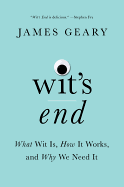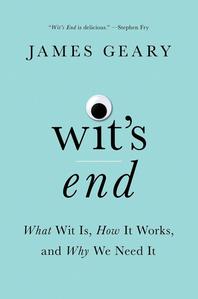
 In books about aphorisms (The World in a Phrase) and metaphor (I Is an Other), James Geary has demonstrated he's someone who admires an elegant turn of phrase. He mines a similar lode in Wit's End, an entertaining exploration of how intellectual dexterity manifests itself in both verbal and visual form.
In books about aphorisms (The World in a Phrase) and metaphor (I Is an Other), James Geary has demonstrated he's someone who admires an elegant turn of phrase. He mines a similar lode in Wit's End, an entertaining exploration of how intellectual dexterity manifests itself in both verbal and visual form.From the beginning of this brief but wide-ranging survey, Geary explains that true wit is about much more than the ability to tell a good joke or a humorous story. His working definition of the term--"the faculty of mind that integrates knowledge and experience, fuses divided worlds, and links the unlike with the like"--sums up his belief that true wit is much more than merely being funny, something "richer, cannier, more riddling."
That thesis is best illustrated in Geary's discussion of puns. Though most people have been taught to regard this form of wordplay as the lowest form of humor, Geary has a particular affinity for the talent it takes when one "folds a double knowledge into words." Citing their prevalence in Shakespeare (with an average number of 78 per play) and the Bible, as well as Abraham Lincoln's special fondness for them, Geary argues that puns illustrate "the essence of all true wit--the ability to hold in the mind two different ideas about the same thing at the same time."
Geary shows off some of his own cleverness in style--or, more accurately, the multiplicity of styles he's chosen here. Between the opening chapter and the acknowledgements--both written in the manner of Alexander Pope's rhymed couplets--he plays with a variety of literary forms. This includes conventional essays, sermons, scientific papers, the African American game of traded insults known as "The Dozens" and a dramatic dialogue between the 18th-century French playwright Denis Diderot and political thinker Madame de Staël.
Geary even touches on the subject of artistic wit. A chapter delivered as if it were an art history lecture, and accompanied by a handful of illustrations, discusses "ambiguous figures." The work of 16th-century Italian artist Giuseppe Arcimboldo in the trompe l'oeil tradition, for example, is "an elaborate visual pun, placing in the mind two different images of the same thing at the same time." To that end, Geary cites the portrait The Admiral, painted out of the images of fish and crustaceans.
In Wit's End, James Geary is undaunted by the risk anyone writing about the subject of being funny takes: spoiling the joke by explaining it. Refreshingly, he shows here that he's fully equal to the task, enhancing our appreciation of how true wit can both amuse and enlighten. --Harvey Freedenberg, freelance reviewer
Shelf Talker: From varying perspectives and in an array of literary styles, word maven James Geary explores the gift of wit.

